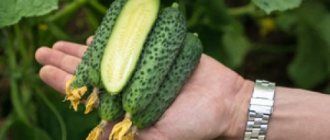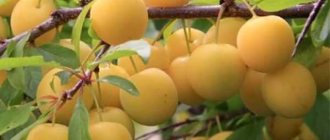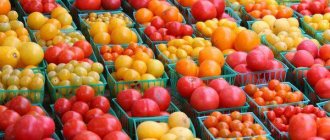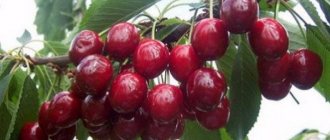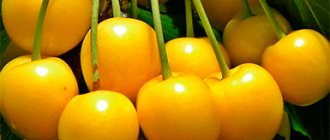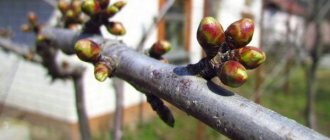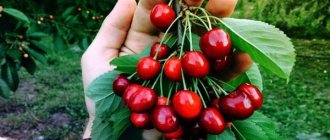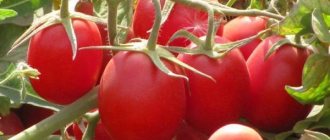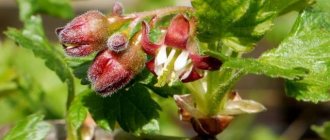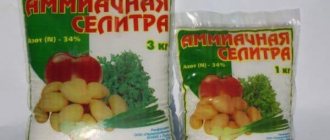Cherry is a tree that is rightly called one of the most beautiful fruit trees in the garden. This is a heat-loving plant that feels best in the south. But breeders have long developed many varieties for a more severe climate, for example, for the Leningrad region. Planting and caring for them are not much different. Therefore, even an inexperienced gardener can grow cherries, receiving a generous harvest of delicious berries every year.
Do cherries grow in the Leningrad region?
The Leningrad region belongs to the North-Western region. The climate here is continental: winters are mild, summers are warm. A special feature of the region is unstable weather conditions during the warm period. The changing climate creates specific conditions for growing fruit and berry crops.
Cherry is a heat-loving tree. For a long time, the territory for its planting was exclusively the southern regions. Through a series of selective experiments, scientists were able to create and grow varieties for the Northwestern region. For many years they experimentally proved the possibility of planting, growing, and developing cherries in a changeable climate. Thanks to their work, the fruit and berry crop has firmly taken root in the farming of the Leningrad region. Modern summer residents plant a variety of species on their plots. They enthusiastically cultivate early and late varieties.
Important! Among the varieties for the North-West region there are very few self-fertile trees. The harvest requires additional frost-resistant pollinators.
Reviews
Inga, Vyborg
We grafted onto an unknown cherry variety Ovstuzhenka. It has taken root well and produces good yields. We don’t know the name of the old variety, but obviously it’s one of the adapted ones, because it’s not afraid of cold weather. We cover it lightly with agrofibre, but so far the plantings have not frozen in any winter. There are not as many berries as in the south, but there are enough for preparations. And so we pluck straight from the tree, especially children try.
Olga, Gatchina
Iput and Tyutchevka grow on my site. They bloom at the same time, so there are no special problems with pollination. Tyutchevka ripens somewhere around July 15-18, and is good at avoiding annoying thrushes. The berries are tasty, covered with leaves, so it seems that they are not on the tree at all. Sweet, even in rainy seasons the taste remains good.
Despite the fact that cherries are a heat-loving crop, gardeners in the Leningrad region managed to adapt them to their climate. Through the efforts of breeders, winter-hardy varieties have been obtained that successfully bear fruit even in the capricious and unpredictable weather of the North-West.
Cherry varieties for the Leningrad region
Cherry is a common planting in the Leningrad region. Specially bred varieties respond well to the region’s rather harsh weather conditions. Main types:
- Orlovskaya amber.
- Ovstuzhenka.
- Victory.
- Pink Bryansk.
- Leningradskaya black.
- Tyutchevka.
Winter-hardy cherry varieties for the Leningrad region
A high level of winter hardiness is an important feature of the variety planted in the Leningrad region. Winters here can be quite harsh. The tree must withstand significant changes in low temperatures. Several varieties show excellent response to cold weather:
- Here we go. Withstands up to -32 degrees.
- Revna. Frost resistance is above average. The tree is able to withstand harsh winters without much damage to the trunk and branches.
- Drogana yellow. It has a high level of resistance to northwestern frosts. The tree's buds tolerate temperature drops down to -20 degrees.
- Fatezh. The plant's buds have average resistance to cold. Trunks and branches cope well with low temperatures.
- Bryansk pink. The trunk and branches are characterized by a high threshold of frost resistance. Tree buds should be protected from sudden temperature changes.
- Leningradskaya black. The variety is a leader in winter hardiness. Thanks to this, it is considered the most popular in the North-West region.
Low-growing varieties of cherries for the Leningrad region
In the Leningrad region, due to the climate, strong winds often blow in the cold season. Low-growing trees will be less susceptible to the destructive influence of drafts and gusts of wind:
- Raditsa. The average height of the trunk with a compact crown is 2-3 m.
- Ovstuzhenka. Low variety. Maximum height – 3 m.
- Regina. The tree is small - 2-3 m.
- Revna. A small variety with a pyramidal crown. Average height – 2 m.
Self-fertile cherry varieties for the Leningrad region
Self-fertility of a tree is the ability to bear fruit without the presence of additional pollinators. Among the varieties of the Leningrad region there are practically no trees with such a possibility. Thanks to selective experiments, the following self-fertile varieties were developed:
- Ovstuzhenka. It is conditionally self-fertile. Its pollination occurs within the same tree.
- Revna. The species does not require additional pollinators to produce fruit.
- Homestead yellow. The variety is self-fertile and produces abundant harvests.
- Large-fruited cherry. The partially self-fertile variety will require pollinators - Valery Chkalov, Francis, Bigarro Oratovsky.
Which cherries are best for the Leningrad region
The Leningrad region is a specific environment for the cultivation of fruit plants. The region is known for its frosty winters, damp, cool summers, and changeable weather. Gardeners in this region consider several varieties to be the most suitable:
- Leningradskaya black. It has a number of undeniable advantages. Thanks to this, it is widely distributed in the areas of gardeners and amateur summer residents. The tree is resistant to severe frosts. The variety is characterized by rapid growth and fruiting 3 years after planting. One of the peculiarities is that ripe fruits do not fall off for a long time. The variety needs additional pollinators (Iput, Tyutchevka, Fatezh, Ovstuzhenka).
- Ovstuzhenka. Early variety. Its fruits ripen in June 5 years after planting. The low tree has a particularly high level of frost resistance.
- Revna. It is characterized by rapid growth and medium-late fruit ripening. A distinctive feature is high resistance to plant diseases.
When is it better to plant: autumn or spring?
The answer to this question directly depends on the climatic characteristics of the region!
Due to the vulnerability of young trees, they are planted in such a way as to minimize the adverse seasonal effects of the environment.
Thus, in the southern regions, with their relatively mild winters and early heat, it is more advisable to “bury” cherries in the fall, so that during winter dormancy the root system has time to form and meet dry winds, insects and the drying southern sun “fully armed.”
In cold climate zones, they avoid planting cherries in winter, because they can simply freeze. Planted in late spring, during a relatively favorable summer the tree will be able to take root and become strong enough to meet the winter as a more or less viable seedling.
Planting cherries in the Leningrad region
The main problem of planting cherries in the Leningrad region is the death of seedlings due to frost. You should follow simple recommendations:
- The cuttings are planted at the end of April. They will have time to adapt to the climate and get stronger before the onset of winter.
- For planting, choose the sunniest place on the site.
- The seedling must be protected from wind and drafts.
- The best option is a hill, a hill. The lowland has a high level of groundwater. This will damage the tree's roots.
Step-by-step planting instructions
The first thing an amateur gardener should do is prepare the soil, digging up and fertilizing the site of the future cherry orchard at least a year in advance.
Then they worry about finding a zoned cherry variety, not being seduced by beautiful photographs on labels, but reasoning sensibly about the seedling’s adaptation to a specific climate.
The next step is to prepare for planting the seedling itself, lowering it into a container of water for a day.
Next, prepare the soil.
At the fourth stage, planting is carried out, not forgetting to sufficiently moisten the soil surrounding the root system of the newly planted tree at the end, pouring at least 30 liters of water there.
Planting begins by pouring a bucket of water into a fairly deep dug hole.
Then a seedling is placed there on a support so that the root collar protrudes 5 cm from the hole.
The hole is filled with earth, covering all the horses, and the soil is compacted.
Growing cherries in the Leningrad region
Growing cherries in the Leningrad region will not cause much trouble if careful measures are taken to care for the plant:
- Regular watering with warm water. Before moistening, the soil is loosened.
- Mandatory fertilization with organic matter.
- Weeding.
- Pruning branches annually.
- Mandatory measures to protect against diseases and pests. A net will save the tree from birds. For diseases – treatment with appropriate solutions of insecticides.
Advice! Every 5 years, the soil around the planting is treated with a lime solution.
Growing Tips
If you select winter-hardy varieties, plant cherries in a place favorable for them, carefully care for them, protect them from pests, and carry out disease prevention, it is quite possible to harvest a harvest of sweet and aromatic berries even in the North-West.
Fertilizer
Since minerals are poured into the hole when planting cherries along with humus, the tree is fed for the first time after a year or two. In the spring, water with diluted rotted manure or fertilize by dissolving 2 tbsp in a bucket of water. spoons of urea.
When flowers appear on the cherry tree, add potassium salt with superphosphate in liquid form. Once every three years, the soil in the tree trunk circle is dug up and compost or humus is incorporated into the soil.
Trimming
In the spring, 3 weeks after planting the tree, the side branches and top are shortened by half. The central trunk is made 20 cm longer than the other shoots. The cherry tree has a crown of 2 or 4 tiers, consisting of 3 branches. Every year, weak growths are cut out and dry and broken shoots are removed.
Severe frosts lead to the death of buds. Only when the leaves bloom do they get rid of the frozen branches. The cut areas are covered with garden varnish or paste. Affected trees are fed with fertilizers containing nitrogen.
Diseases and pests
Varieties bred for cultivation in cool climates are immune to viruses, but in wet weather they are affected by fungi that cause hole spotting and gray rot. To prevent the activation of pathogenic microorganisms, after flowering the trees are sprayed with Bordeaux mixture or copper sulfate. The second processing begins by collecting the berries.
To prevent hole spot in early spring, cherries are sprayed with Nitrafen.
Stone fruits growing in the cool climate of the Northwest are subject to attack by:
- sawflies;
- leaf roller;
- cherry flies.
To cope with harmful insects, in early spring and several more times the trees are sprayed with insecticides - “Iskra”, “Aktellik”, and treated with “Karbofos”. Nets, stuffed animals, and shiny disks that hang on trees help protect the berries from starlings and sparrows.
Harvest rationing
In the Leningrad region, the fruits of stone fruit crops do not always have time to ripen. To speed up the ripening of cherries, cut off the excess ovary. The first flowers that appear on young plants are completely removed.
How to choose seedlings
When buying a tree to grow in your summer cottage or yard, you need to carefully consider it. You need to purchase cherries with a smooth, even trunk and root collar without damage. The leaves should be free of stains, plaque, and traces of insects. It is necessary to buy fruit trees that are adapted to the local climate.
The best varieties of cherries for the North-West
The Northwestern region covers several areas with variable cold climates. The cultivation of fruit and berry crops here is associated with strict selection of varieties in accordance with frost resistance and self-fertility of trees.
Winter-hardy
Frost resistance is the main criterion by which a plant is chosen for planting on its plots. They have high winter hardiness:
- Orlovskaya amber. The early variety is highly resistant to frost. Withstands up to -20 degrees without damage.
- Bryansk Pink. The tree responds well to temperature changes in winter.
- Cheremashnaya. The early variety tolerates frost well. Branches and buds are not damaged at temperatures down to -20 degrees.
- Homestead yellow. Can grow in conditions down to -30 degrees.
short
Low-growing varieties in the North-West region are valued as highly as frost-resistant ones:
- Raditsa is a low tree with a very compact crown.
- Veda. A low variety with a spreading crown.
Self-fertile
Self-fertility is a significant advantage of varieties in the North-West region. Few species can survive without a pollinator:
- Cherry Narodnaya Syubarova. The tree reaches a height of 6 m. It does not require additional pollinating varieties to produce fruit.
- Homestead yellow. Produces a harvest of sweet yellow fruits without the help of pollinators.
Harvest and storage
Cherry fruits must be harvested without allowing the berries to fully ripen. This will ensure better transportability and allow you to preserve the fruits longer. The berries must be picked together with the stalks into special small plastic boxes. Select only healthy fruits without damage. The shelf life of the crop ranges from several days to 2 weeks, depending on the variety. Recommended storage temperature is 0... 4°C.
Thanks to the efforts of breeders, these days it is not difficult to grow heat-loving cherries in areas with colder climates. Self-fertile varieties are clear proof of this. Because they do not require pollination, they have low growing requirements and, in most cases, resist standard diseases and pests well.
Growing cherries in the North-West
There are a number of features of growing fruit and berry crops in the frosty climate of the North-Western region:
- Creation of artificial protection from drafts and winds.
- Careful selection of landing sites. It is necessary to monitor the groundwater level.
- Optimal watering.
- Feeding. Tree fertilization is carried out in accordance with the season. It is important to support the plant during the period of flowering, fruit set, and before the onset of cold weather.
- Despite the high frost resistance, cherries should be additionally insulated. The roots are covered with pine sawdust, the trunk is treated with a lime solution.
Characteristics of cherries
Cherry is a representative of the kingdom of plants that form the tree trunk, for which it is considered a tree of the first magnitude.
Most likely, the cherry originated more than eight thousand years ago from cherries widely cultivated in ancient Europe and Asia (in the site of modern Turkey).
Actually, the sweet cherry is the closest “relative” of the cherry, and medieval botanists learned to confidently distinguish both fruit crops only by 1491.
In the form that is known to modern man, the Ancient Romans already knew cherries, calling them “Curasunta fruits” in honor of the ancient city.
Cherry belongs to the taxonomic system unit (species) of the genus Plum, and the family that includes cherry bears the poetic name “Pink” (also called Rosehipaceae).
With proper care, young cherry plants grow amazingly quickly, gradually forming an ovoid or cone-shaped crown of an adult tree.
Variety selection
If you are not planning to plant more than two cherry seedlings, then it is very important to choose the right variety so as not to be disappointed later.
Using botanical classification, in gardening there are two types of cherries:
- soft-fleshed guinea;
- hard-fleshed bigarro.
Those who want to enjoy juicy, tender berries as early as possible should choose varieties marked “gini”: they ripen early and are suitable for immediate consumption while they are fresh.
If the owner of a cherry tree intends to harvest berries for future use and is in no hurry to ripen the crop, the variety should be labeled “bigarro”: such berries are denser in texture and shelf-stable.
In total, four thousand different varieties of cherries have been bred in the world, of which 46 are the achievements of domestic breeders.
No less important is the approach of responsible and adequate choice when searching for winter-hardy varieties.
The most proven ones in this quality were:
- Revna;
- Northern;
- Tyutchevka;
- Memory of Syubarov;
- Italian;
- Fatezh.
For St. Petersburg and its environs, “Yurga”, “Leningradskaya black”, “Teremoshka”, “Seda”, “Bryanskaya pink” are best suited.
Another advantage of modern varieties is that the trees can be grown, depending on the variety, into giant and also dwarf ones, not exceeding the three-meter mark.
Based on the color of the skin and pulp, the gardener is free to choose from the following varieties:
- yellow-fleshed;
- red;
- pink;
- deep red, almost black.
Botanical features of cultivation
The specifics of growing berries in the North-West region lie in the peculiarities of the local climate.
On the one hand, a small number of sunny days and abundant snow cover, possible frosts. On the other hand, the geographical proximity of the sea softens the vagaries of nature. The Leningrad region is a region where it is impossible to let the process of pollination of fruit trees take its course. Always plant 2 winter-hardy varieties next to each other. The second feature of growing cherries in the region is that work begins as the temperature stabilizes. The ovaries form as soon as there is no cold or increased temperature for 3-4 weeks. A mild, dry climate is a prerequisite for the selected juicy cherry variety for the North-West to bear fruit. The third feature is that low-growing varieties are planted within the Leningrad region. The reason is that small fruit trees are easier to care for.
The fourth feature is that amateur gardeners have developed varieties that are planted in summer cottages. The varieties listed are not suitable for industrial cultivation.
| View | Variety name | Note | |
| Self-fertile varieties | "Mountain Woman" | Cherries will delight you with juicy and sweet crimson pulp | The tree can withstand prolonged cold, but does not tolerate drought well. |
| "Hostel" | The basis for the creation was frost-resistant cherry | The average weight of disease-resistant berries is 6-10 g | |
| "Astakhov's Favorite" | Sweet burgundy pulp | The average weight of a fast-growing variety exceeds 9 - 12 g | |
| Winter-hardy - represent hybrid varieties | "Bryanochka" | Provides medium to moderately sweet berries in the Northwest | Withstands short-term cold snaps, but does not tolerate drought well |
| "Leningrad yellow" | If you check the description, it indicates a rich dark red color, moderately sweet taste | It is recommended to plant for beginners who do not have sufficient experience in handling hybrid crops. | |
| "Tyutchevka" | Winter-hardy, moderately sweet, flesh not juicy enough | Withstands short-term cold down to – 30 C | |
| short | "Ovstuzhenka" - resistant to cold, but does not tolerate dampness | Juicy, moderately sweet berries are formed in 3-4 years | The cuttings are planted on a dwarf rootstock, so the height of an adult tree does not exceed 2.5 m |
| "Raditsa" - resistant to pests and bacterial flora | Large, very sweet berries | Replacement is carried out at 10-11 years |
In the Leon region, attention is paid to early ripening varieties. Summer residents who choose Bereket get a good harvest. The first “plus” is that pollinators are not planted nearby. This saves space on the site. The second “plus” is that the fruit tree is frost-resistant.
How to care for cherries
Caring for cherries after planting is practically not required:
- The main thing is to protect it from rodents, frostbite, damping off and sunburn. To do this, the trunk should be whitened, wrapped in burlap and toxic chemicals should be spread out. In cold winters, it is better to add snow.
- In the spring, when the snow melts, the trunk and skeletal branches are whitened to reflect the sun's rays and to prevent disease.
- During the growing season, cherries require watering 1-2 times a month: young ones require 2 buckets, adults – 5-6 buckets of water.
- For the first 2-3 years, only nitrogen fertilizers are applied in the spring - they stimulate the growth of branches and green mass.
- Starting from the 4th year, the full mineral complex is added.
The soil under the trees can be mulched, turfed, or kept fallow.
How to choose and plant cherries correctly
Before purchasing, you need to decide in advance whether this plant will be rooted or on a rootstock. If the second option, then when purchasing, you need to find the grafting site - it has a pronounced thickening just above the root collar.
In addition, the tree must have a main conductor, which will subsequently become the main trunk, and pruning will be done with an eye on it. If there is no central conductor, then the result will be a highly branched plant with a high risk of breaking the crown during the fruiting period.
Immediately before planting, the plant is inspected again to identify any shortcomings and:
- remove “soaked” roots;
- trim very long root ends;
- cut off those roots that do not fit into the planting hole;
- tear off remaining foliage.
Under no circumstances should branches be cut, unless they are broken during transportation.
If there are dried roots, before planting they are placed in water for several hours (from 2 to 10) to become saturated with moisture.
When the seedlings are dealt with, you need to determine a favorable place for planting cherries. This should be a well-lit area, protected from the north wind.
It “feels” best on loams and sandy loams with good aeration.
The planting site is carefully dug up, weeds removed, and leveled with a rake. Planting holes are planned at a distance of 4-5 meters from each other. Their diameter and depth are 80-90 cm. When the cherry orchard is planned and the holes are ready, the following is added to them:
- humus - 3 buckets;
- ash – 1 l;
- superphosphate – 0.2 kg;
- potash fertilizers – 0.1 kg.
In addition, if the soil is clayey, a bucket of sand is poured into the hole; if the soil is sandy, a bucket of clay is poured into the hole. Mix everything with a shovel and form a small mound in the center for convenient placement of the roots.
You can start planting. First, a support peg is stuck into the hole, then the seedling is placed strictly vertically and the roots are carefully straightened along the slopes of the mound. It is necessary to ensure that the root collar and the scion site (if any) are 3 cm above the ground surface. The roots are sprinkled with soil, shaking the tree periodically. When the process is half completed, a bucket of water is poured into the hole and planting is completed. The earth around is carefully compacted.
Then, they tie the plant to a support and, stepping 30 cm around the circumference from the trunk, make a small depression into which another bucket of water is poured. It is advisable to mulch the planting site with rotted sawdust or compost. If the soil settles after a few days, it should be added to the general level.
How to plant correctly
In order for the tree to develop and the fruits to ripen, it must be placed in an area where the heat-loving crop will be comfortable.
Selecting a location
Sweet cherries require light and bear fruit well if grown in the sun. When placing a seedling, you need to ensure that shadows from other trees do not fall on it. For a heat-loving crop, it is advisable to choose a place on a southern slope, closed from northern winds. The fruit plant does not take root in lowlands, swampy areas where cold air accumulates.
Bad neighbors
It is better to plant cherries, even of a self-fertile variety, next to the same stone fruit crop as itself.
Apple tree
Many summer residents place plants on the site without taking into account compatibility. The leaves of trees and shrubs release components that can deplete the soil and change its composition. The apple tree takes away nutrients and moisture from the cherry, preventing it from growing and developing.
Pear
Stone fruits should not be placed near fruit trees whose roots secrete a large number of compounds. They do not get along well with pear trees.
Plum
The cherry develops normally, grows and bears fruit in the vicinity of the cherry, which acts as a pollinator, and with rowan; a lot of berries are laid and everything ripens. It is not recommended to plant plums together with southern crops, which have a weaker root system.
Digging a hole
Sweet cherries love loose soil and do not survive in areas where water comes close to the surface. The pit for the tree should stand for a month or 3 weeks. If planting is done in the spring, in the fall you need to dig a hole to a depth of 60 cm and a diameter of about a meter. Fertile soil is combined with 2 buckets of humus, 60–80 g of potassium salt and superphosphate are added. The pit is filled 2/3 with the mixture and watered.
Landing
Cherries are placed at a distance of 5 meters from fruit crops. The leaves of the tree are torn off, the roots are lowered into water for about 6 hours. A small mound is made at the bottom of the hole, a seedling is placed vertically on it, and soil is sprinkled on top. The soil is compacted and watered abundantly. The tree trunk circle is covered with mulch.
Transportation
Seedlings must be purchased from a nursery or nature reserve. Sweet cherries are grafted onto Vladimir cherries or other varieties that are not afraid of the cold. A tree a year or two old takes root well. For transportation over long distances, the roots are wrapped in wet newspapers in 3-4 layers, packed in plastic film or simply covered with sphagnum moss.
